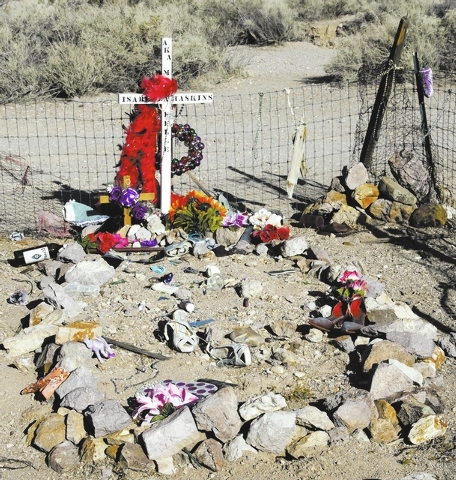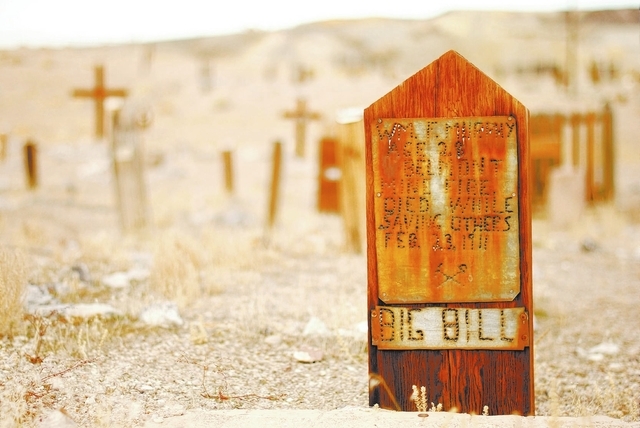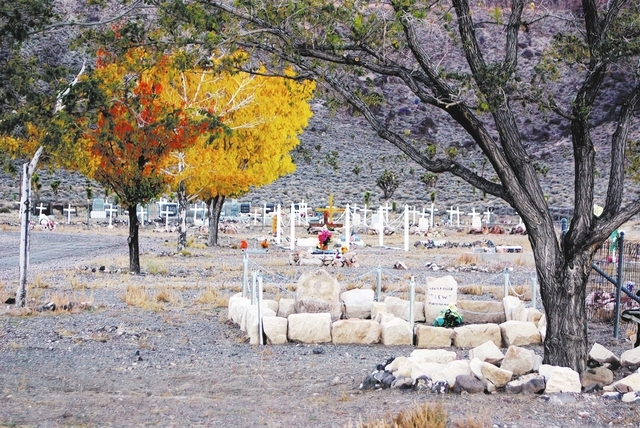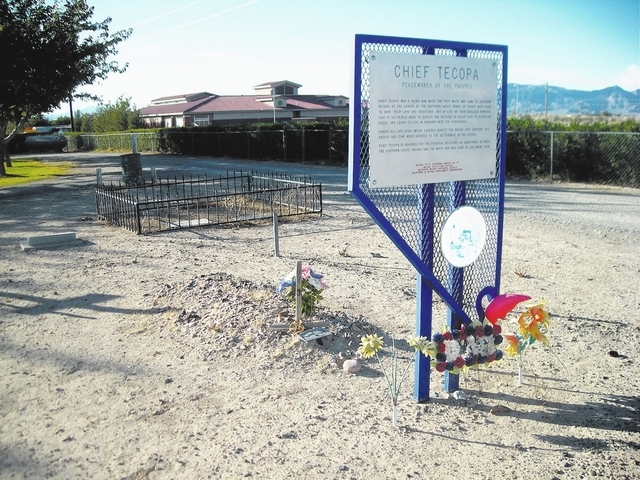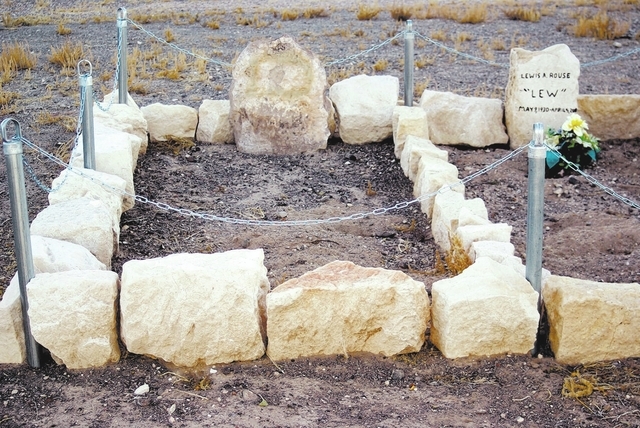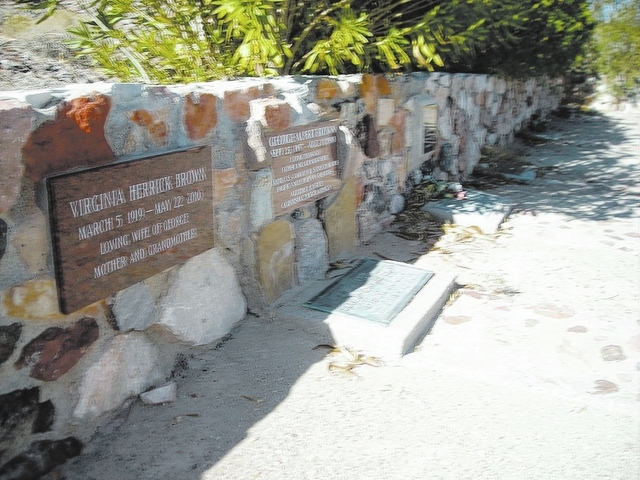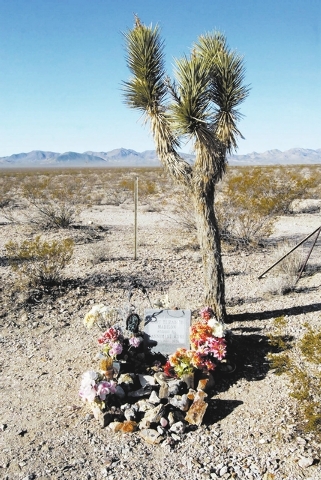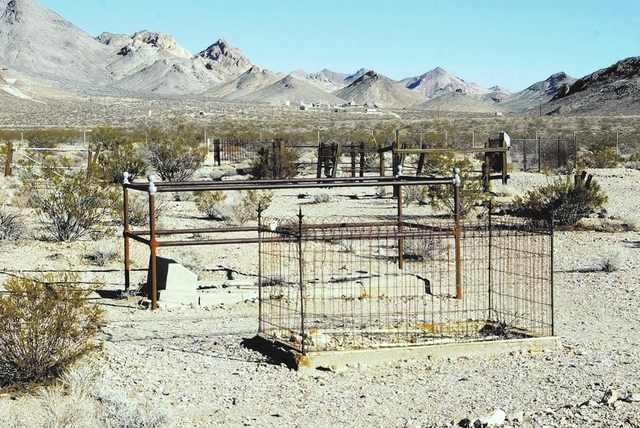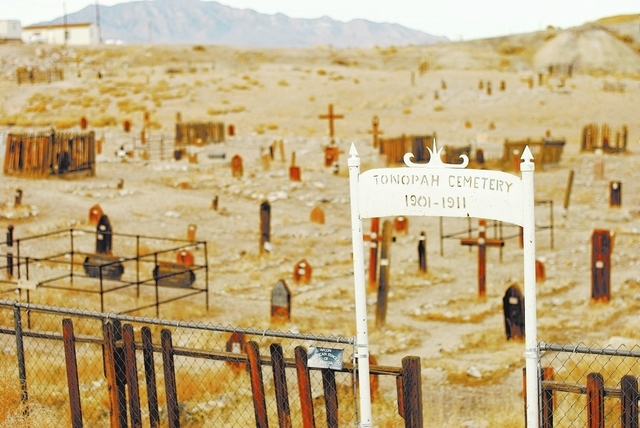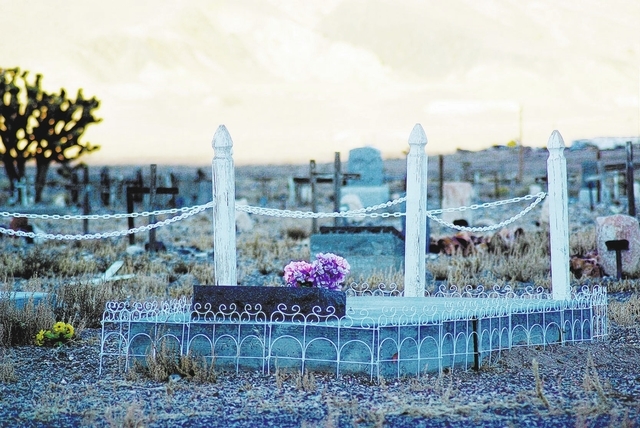WHERE THE BODIES ARE BURIED: Cemeteries offer portal into area’s past
A few published accounts report Butch Cassidy is buried in a grave in Johnnie, long after escaping a deadly shootout in Bolivia in 1908.
Local residents may not find the famed gunslinger’s grave, but they can certainly find Chief Tecopa’s resting place.
His grave in the Pahrump cemetery that bears his name is marked with a State of Nevada historical marker.
It reads: “Chief Tecopa was a young man when the first white man came to southern Nevada. As the leader of the southern Paiute tribes, he fought with vigor to save their land and traditional way of life. He soon realized however that if his people were to survive and prosper he would have to establish peace and learn to live in harmony with the foreigners.”
An Indian section sits in the west wing of Chief Tecopa Cemetery. The remainer of the plots are filled with prominent valley residents. There’s Robert Ruud, 1928-1983, Harry Stanley “Button” Ford, a Pahrump resident since 1946, who died in 2011 and Leslie “Bill” Mankins, with a picture of a golfer; he lived from 1926 to 2001.
Compared to many of the area’s cemeteries, and they are numerous, Pahrump’s is fairly new. Still, it has its quaint history, too.
Philip Raneri, a member of the Pahrump Valley Museum board, said a few years ago when a ranch was going to be developed there were reports of a body buried there. The man was shot in the leg and died on the property. Before it was developed, archaeologists from the University of Nevada, Las Vegas brought equipment out and the remains were found, Raneri said. The still unidentified man is now buried in the Chief Tecopa Cemetery.
“This guy does have a bullet in his leg but we could not confirm it, so it says, this is an unnamed person,” Raneri said.
Belmont fire victims fill Tonopah’s early resting place
Pahrump history is relatively recent compared to mining towns like Tonopah. In addition to the modern Tonopah cemetery is an older plot of land next to the Clown Motel with a number of small, wooden headstones, many in memory of the miners who lost their lives during the Belmont Mine Fire on Feb. 23, 1911. The grave of Big Bill Murphy, who died saving miners at age 28, is one of them, a tin plate on a wooden gravestone reads “died while saving others.”
Historical author Robert McCracken’s book on the history of Tonopah states the Belmont Mine was Tonopah’s second richest producer and one of the most modern and well equipped in the state with expansive developments in the lowest reaches between the 900 and 1,166 foot level. The cause of the disastrous fire was never determined. It began at 5:30 a.m. Mike Kuliache was bringing timbers down the shaft when he smelled smoke at the 1,166-foot level. Shift boss Frank Burke asked to send several timber men through the Desert Queen shaft.
McCracken reported the night hoist operator went off duty at 7 a.m. turning it over to a less experienced man. The last survivors said there were still men at the 1,100 foot level, but mine rules stated the cage should only be lowered in response to a signal. There was none.
The fire caused less than $5,000 damage but took 17 lives. Many of the victims were foreign born, the average age of 15 men whose ages were known was only 30. Slavic miners shook their fists and shouted at the head frame after the fire. The Tonopah Belmont Company settled with 14 victims’ relatives for $43,633.
Twenty-three years later, on Oct. 31, 1939, fire again struck the Belmont Mine. One hour after quitting time smoke began pouring out of the shaft as the timbers burned. An updraft caused by the many connections between the Belmont and other shafts intensified the smoke and fire. Heat warped the steel head frame. The cause of the second fire was never determined and the shaft never reopened. There was no loss of life.
The inscription on a grave published in the Nevada Tombstone Record Book, a listing of Nevada cemeteries and who is buried in them, describes the inscription on the grave of Joseph Jr. son of Joseph and Jane A. Sylvester, born Nov. 2, 1890, died Dec. 11, 1891: “tis a little grave but oh have care, for world wide hopes are buried there.”
McCracken’s history of Beatty talks about Shorty Harris, who discovered some gold in Death Valley but never became wealthy. He died Nov. 10, 1934 and is buried in Death Valley. His epitaph is said to read: “Here lies Shorty Harris, a single blanket, jackass prospector.”
The founder of Beatty, Montillus Murray (Jim) Beatty, who founded the Landers Ranch in 1896, married a Paiute woman. The town became a supply depot for nearby mining towns like Rhyolite, which had 6,000 residents in 1907, the fourth largest city in Nevada at the time behind Goldfield, Tonopah and Reno. Beatty’s gravestone, upon his death in 1908 at 73 states, “the last of the squaw men.”
In January 1954, Walter Edward (Death Valley) Scotty died and was buried on a hill near Scotty’s Castle in northern Death Valley
Information on the Southside Cemetery in Rhyolite is included on an informative website about the ghost town. The graves include Civil War veteran Elmer V. Dunlap, 1848 to 1904, a native of Sidney, Ohio, who served in the Missouri volunteer regiment. Naomio Gonagill, who lived from 1888 to 1904, died of typhoid fever at age 16. Earle Kirchen, 8, died after presumably playing with matches, which caused a five-gallon can of kerosene to explode in the rear of their house.
A sizeable headstone surrounded by a fence marks the grave of Daniel G. Kennedy, who immigrated from Nova Scotia in 1884 and died in 1905.
A statement of facts in the court case over the murder of Rhyolite saloon keeper Byron Nelson stated Asencion Mangana, with malice afterthought, killed Nelson stabbing him with a sharp instrument. Nelson was in the habit of cashing checks of different employees of the railroad on paydays. On June 15, 1909, payday, Nelson didn’t cash them because a station agent or employee of the railroad had sufficient money to cash the checks. Mangana knew Nelson had sufficient money on hand and remained in the saloon until other patrons left. Nelson’s body was found the next day.
A newer grave in the cemetery is the burial place of a woman prospector in the Bullfrog Mining District, Mary Elizabeth Madison, aka “Panamint Annie,” who lived from 1910 to 1979. She lived in the mining camps of Death Valley and moved into a shack. Author Claudia Reidhead said Panamint Annie often fed her children rattlesnake or rabbit stew when times were hard. She had a colorful vocabulary and independent ways that seemed scandalous at the time, but she was described as a caring mother, well educated, who taught her children the way of nature and the book.
Cemeteries dot small towns, in northern Nye
Nye County Commissioner Lorinda Wichman persuaded her board to spend $40,000 on appraisals and other costs to get another 12 acres from the U.S. Bureau of Land Management for the seven-acre Manhattan cemetery, which is full. She said the cemetery, which dates to the 19th century, has a lot of grave markers that were put up with wood, over the years the carvings became weathered, broken and disintegrated.
“The people who were still doing burials up here told me nobody else can be buried in the Manhattan cemetery until we are able to expand the boundaries, because I’m not digging any more graves there, every time I do I run into bones,” Wichman said.
There’s an Indian side of the cemetery, where she said the graves aren’t marked on purpose, for fear grave diggers will uncover artifacts. Wichman said local officials got a call from someone in California who had two wooden markers that were stolen from the Manhattan cemetery. Hopefully, she said local old-timers, who like the saying goes “know where all the bodies are buried” can tell the officials who is in the cemetery.
One grave at the Manhattan Cemetery, for Charles H. Marshall, 1927 to 1999, states: “Born 100 years to (sic) late, caught gold fever in Manhattan about a mile from here. It ends here where it began.”
Dale Rodrigues, at Darroughs Hot Springs, two miles north of Carvers in Big Smoky Valley, has a family cemetery on her property, which was also a tradition in the pioneer days. It includes the body of her great-grandfather, who died in 1911, three of his six sons are also buried in the family cemetery. There’s six bodies altogether in the cemetery, she said.
Besides her attempts to preserve the ranch cemetery, Rodrigues is involved in a project to renovate the old Round Mountain cemetery.
“The Round Mountain Cemetery is pretty much a disaster as it is. We have been trying to get some donations and spruce that place up a bit. At the end of this month we should be having a sign, one of our donors gave us some money,” she said. “I’ve done primarily the research, we have a lot of graves with no names.”
She found 27 Indian graves in the Round Mountain cemetery, but said “it’s a travesty to look at.”
McCracken’s upcoming book on Tybo, 50 miles east of Tonopah, states it was common on the sagebrush frontier for ranchers to have a small graveyard on the property. Joe Clifford is buried on the Clifford Ranch.
J.B. “Giovanni” Fallini who lived in the Tybo area in the 1890s, started Eden Ranch on the east side of the Kawich Ranch and picked out a small knoll with a cedar tree where he asked to be buried. There are five graves at that spot, including that of his eldest daughter, one of six children.
J.T. Williams, who was a pioneer at Hot Creek, east of Tybo, had four children, but only one lived to old age, McCracken wrote. The first one buried in the family cemetery was seven-year-old Robert Williams who was thought to have gotten very ill eating green watermelon. Over the years a number of family members were buried there.
Several family members of George Ernst, a jack-of-all trades, farmer, cattle rancher, prospector and father of eight children, are buried at the Belmont Cemetery inside a beautiful, crafted wrought-iron fence. The second white woman who came to Belmont during the gold boom in 1865, Grace McCann, gave birth to a baby that only lived four months and is buried in Belmont. McCann was part of one of the earliest families to settle in Central Nevada, who escaped the famine in Ireland.
A guidebook to Shoshone cemetery
Closer to home, the website Find A Grave lists 33 people buried at the cemetery outside Death Valley Junction, just south of town on Highway 127, the road to Shoshone and Baker, Calif. Many of the names are Spanish, like Rito Martinez Robles, beloved husband and father, who was born in Durango Mexico in 1912 and died in 1988. A big wooden cross marks the gravesite of Martin Zapata, 1898-1936 and Benny Zapata 1932-1997. Many graves are unmarked.
Then there’s Daniel Britton, who lived from 1955 to 1987. His grave lists this epitaph: “I was rich, if not in money in many hours and summer days and spent them lavishly.”
A grave for Helen Beckett, who lived from 1893 to 1984, states, “I have spread my dreams under your feet, tread softly because you tread on my dreams.”
Farther south, a guidebook to the Shoshone cemetery is on sale at the Shoshone Museum in that community. The cemetery is on a hill behind the post office and village office, on the road to the miners’ caves in Dublin Gulch. The founding fathers, members of the Brown and Fairbanks families, who have owned the land since Charles Brown leased it from the Tonopah and Tidewater Railroad in 1913, are interred in a rock wall at the entrance to the cemetery.
It includes the grave of Senator Charles Brown who lived from 1883 to 1963, he was a county supervisor from 1924 to 1939 and state senator from 1939 to 1959, who established the first school in Shoshone. The grave of his second son, Charles “Fairbanks” Brown, 1917 to 1998, states, “the soul of the virtuous man is in the hands of God.”
A grave belongs to Joseph J. Vollmer, born in Cologne, Germany in 1858 who died in 1938 of pneumonia. He came to Shoshone in 1922, was one of the original residents of Dublin Gulch who built many of the cave homes and lived there until his death.
The cemetery contains gravesites of other former residents of Dublin Gulch like Joseph Allison and James Frederick Belfield. Al Lambert’s grave is in the cemetery, he was shot and killed by Dan Foley in August 1924, after a bout drinking a gallon jug of whiskey turned sour. A newspaper account said Lambert started a verbal argument that escalated into a fight, Lambert ran after Foley with a knife. Foley passed his wagon and grabbed a rifle, striking Lambert in the breast, the bullet followed a downward course and came out below the left shoulder blade. Lambert took the gun away from Foley but as he reached back to strike Foley, fell over dead.
The Tecopa Cemetery is marked by a sign on the Tecopa Road heading into that community, just before the elementary school, but after the turnoff to the China Ranch Date Farm. A number of identical, white crosses dot the landscape.
The tombstone at the family gravesite of Barbara and Anthony Lawrence reads: “at the going down of the sun and in the morning we will remember them arm in arm, we will walk again, you and I together.”
Ethel Messer, a volunteer at the Shoshone Museum, said there’s also an ancient cemetery on Noon Day Mine Road in Tecopa, it’s unknown who’s buried there. It was about the time when Tecopa was first developed as a mining area.
A worker at the Pahrump Museum said there is a gravesite at Stump Springs, on the Tecopa Road, just across the California line. A historical marker proclaims John C. Fremont found the water source at the site unreliable in 1848. Orville Pratt stopped in 1848 at Stump Springs, the only water source on the Old Spanish Trail between Mountain Springs and Resting Springs near Tecopa.


